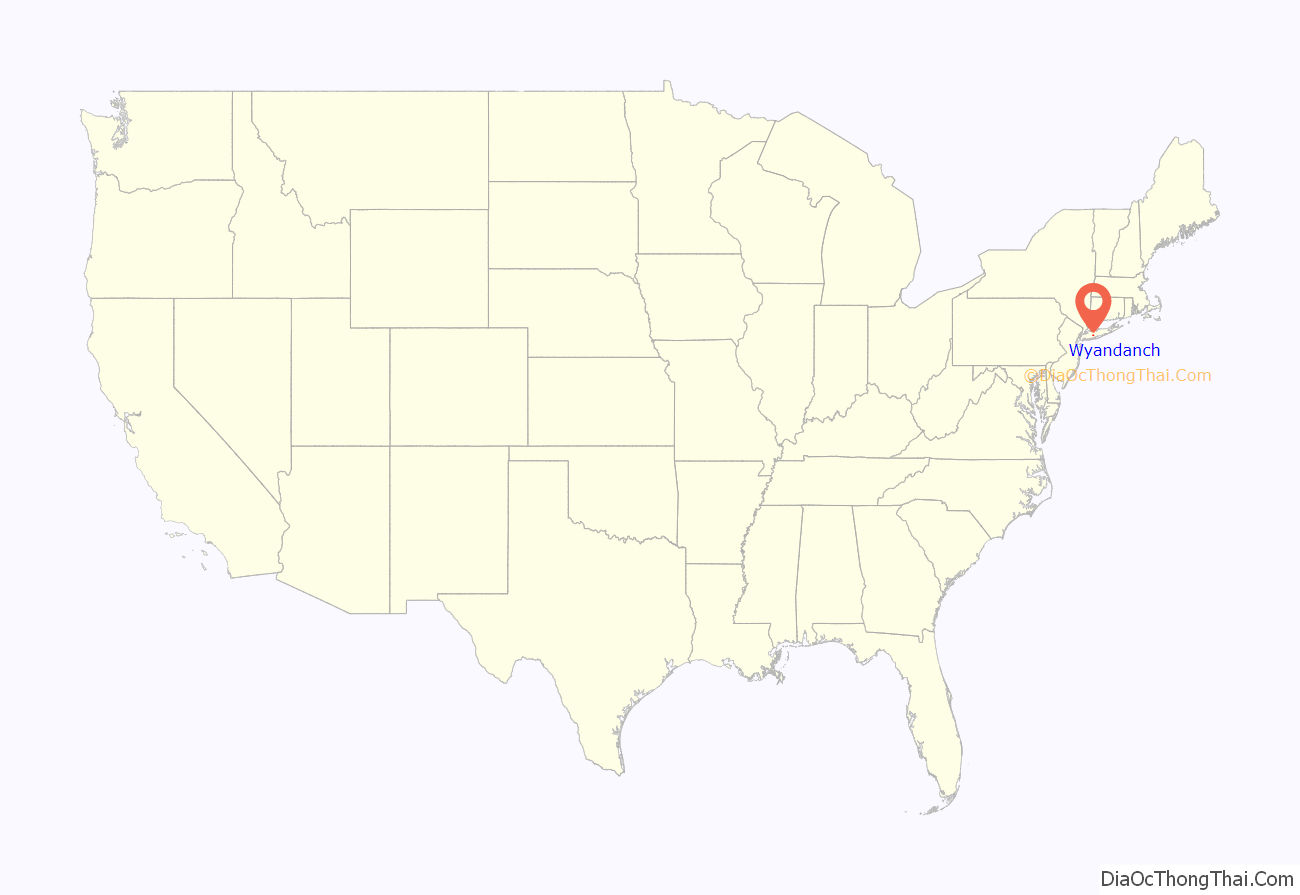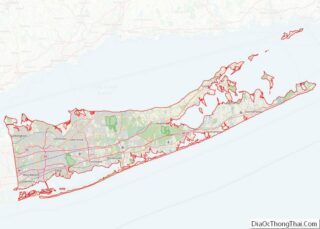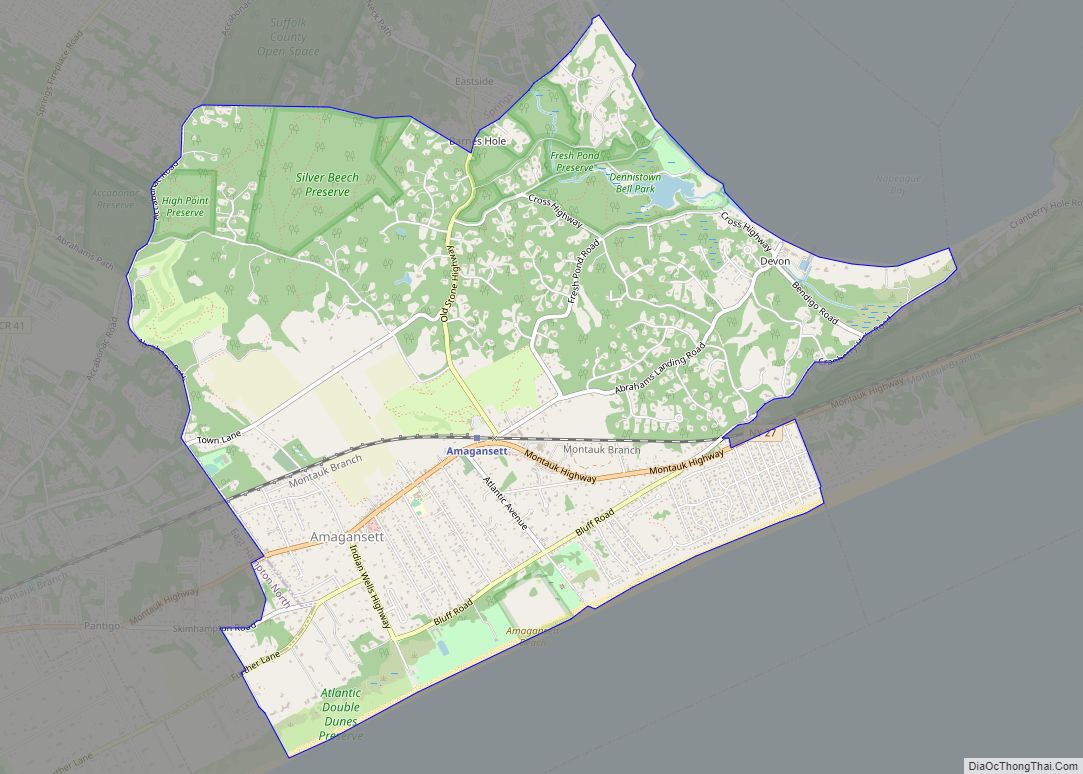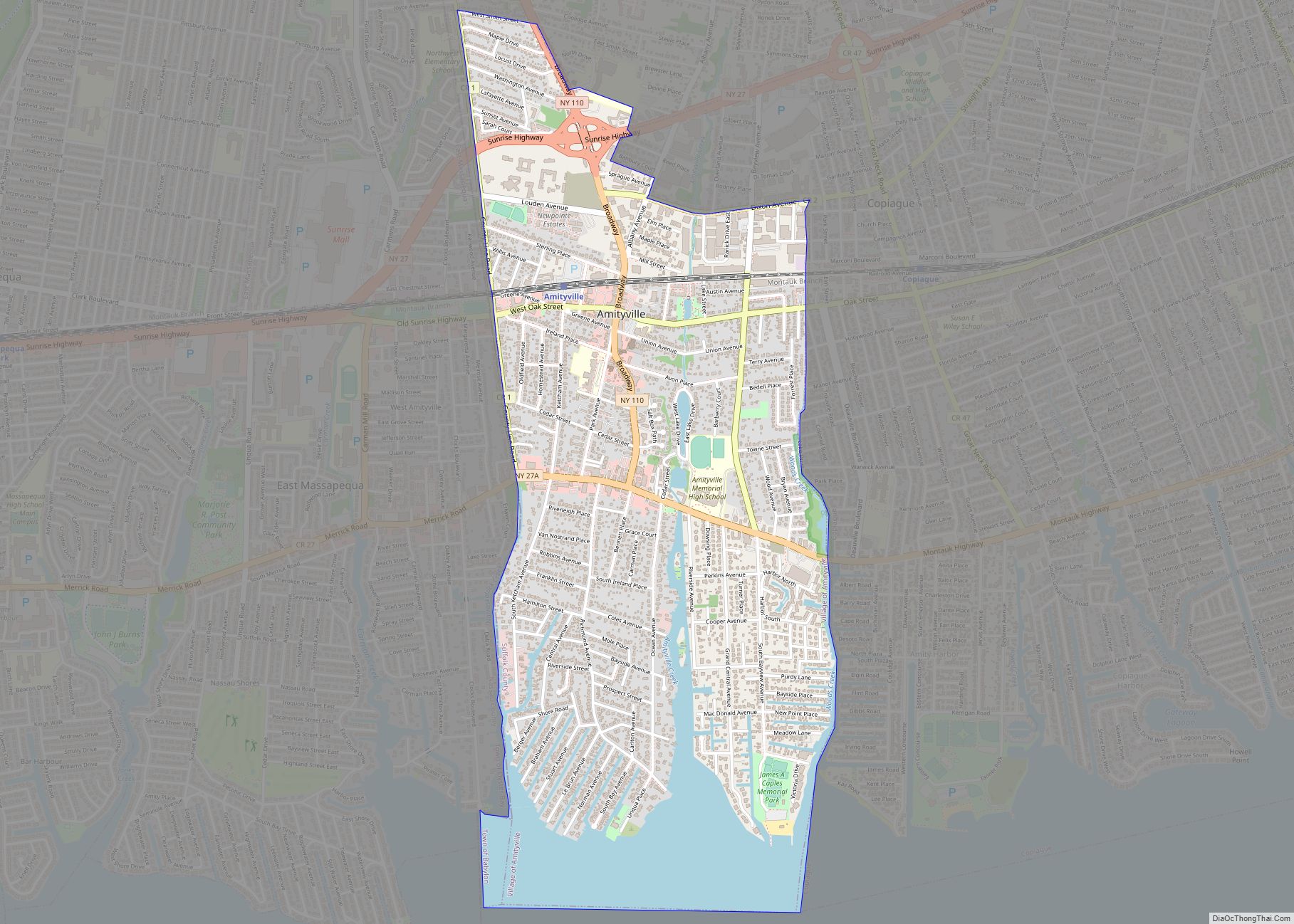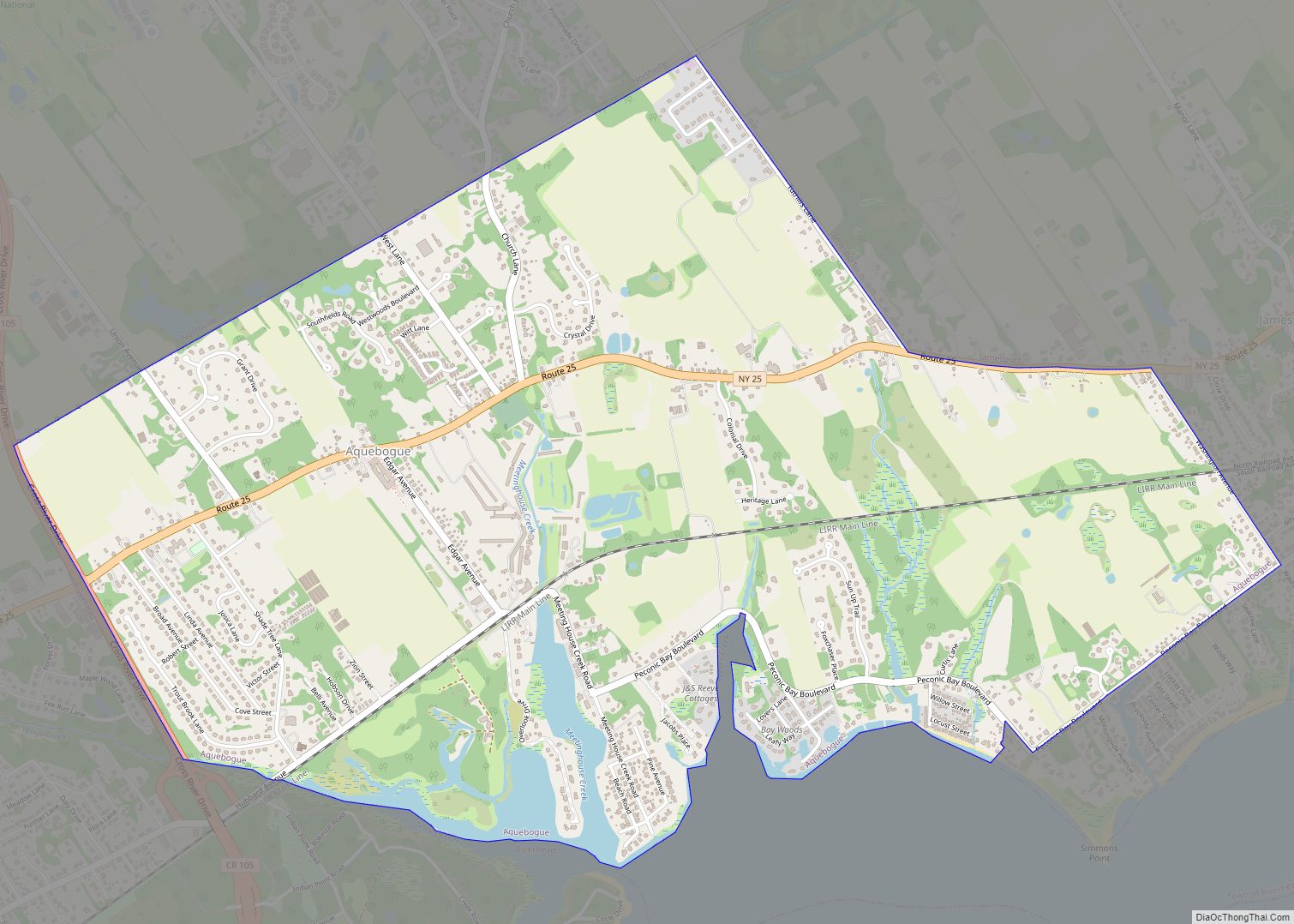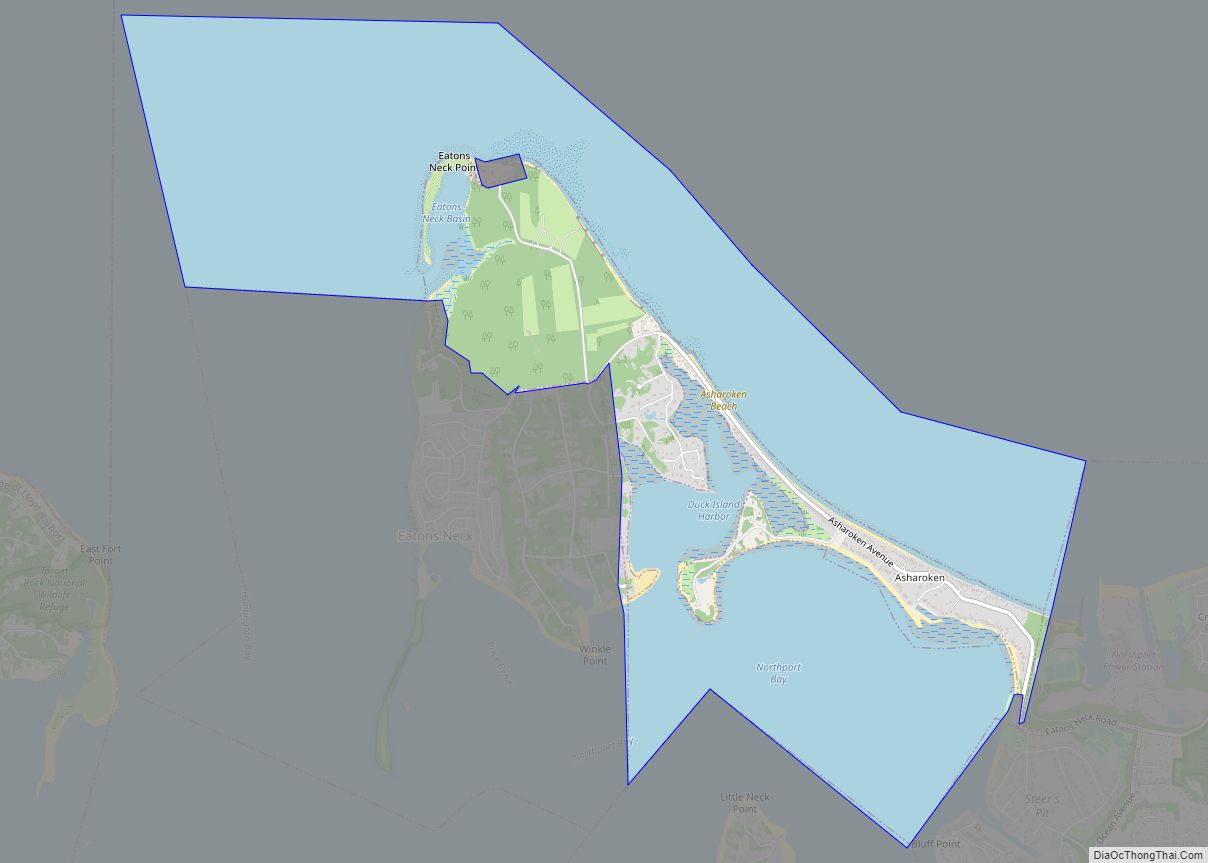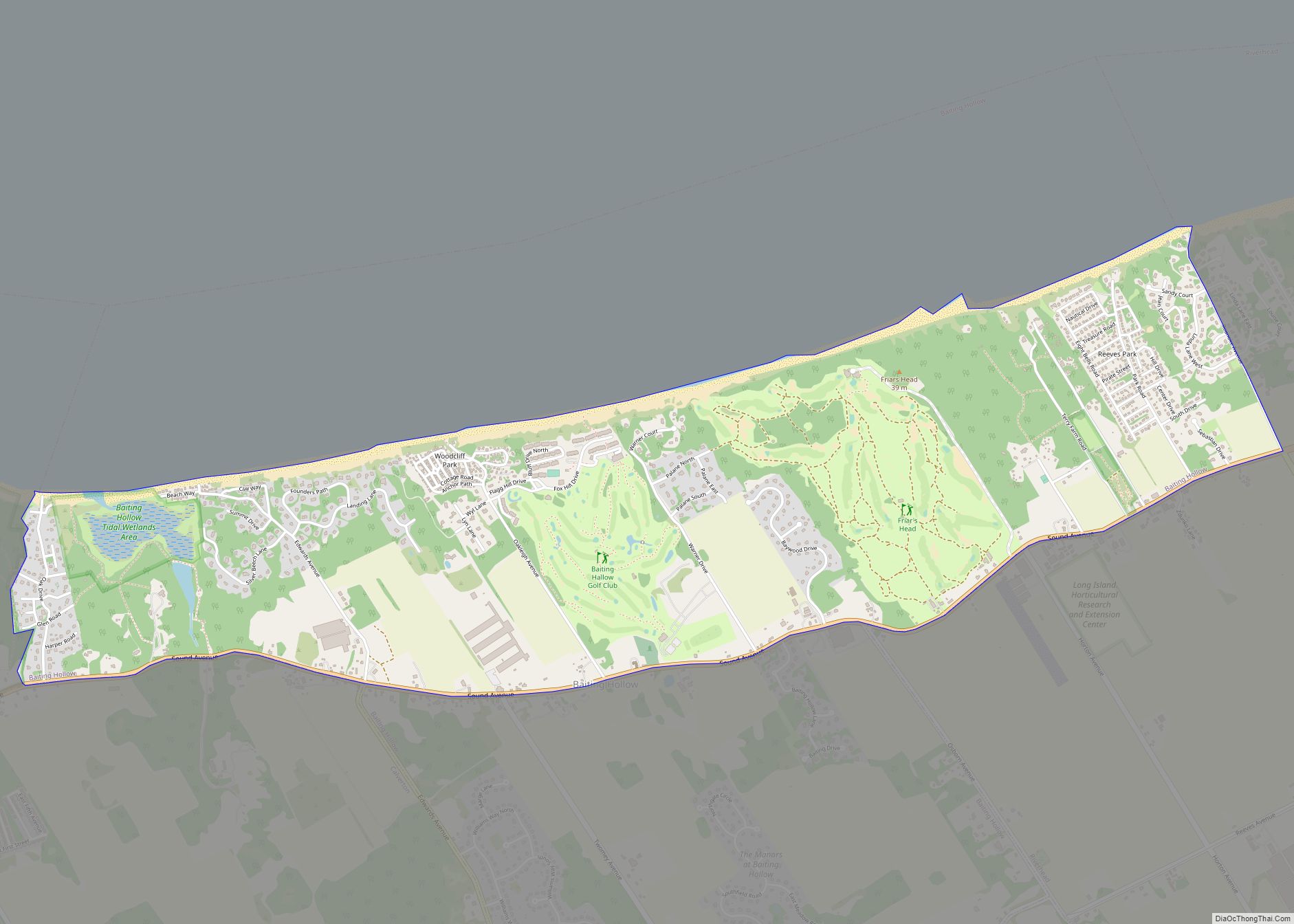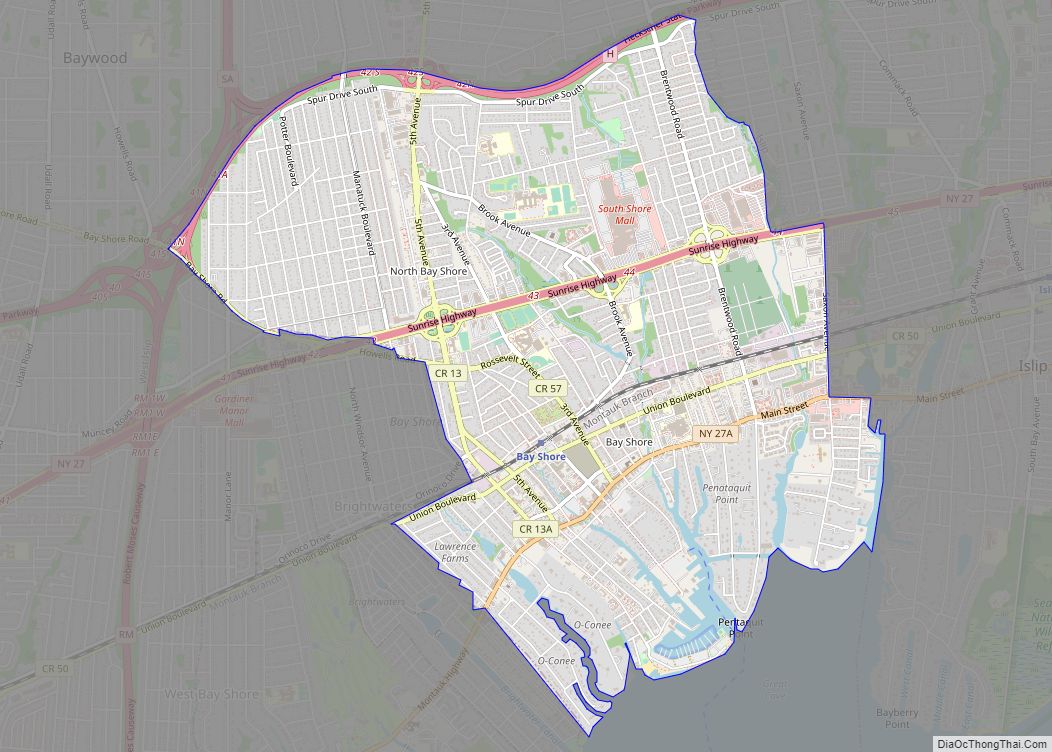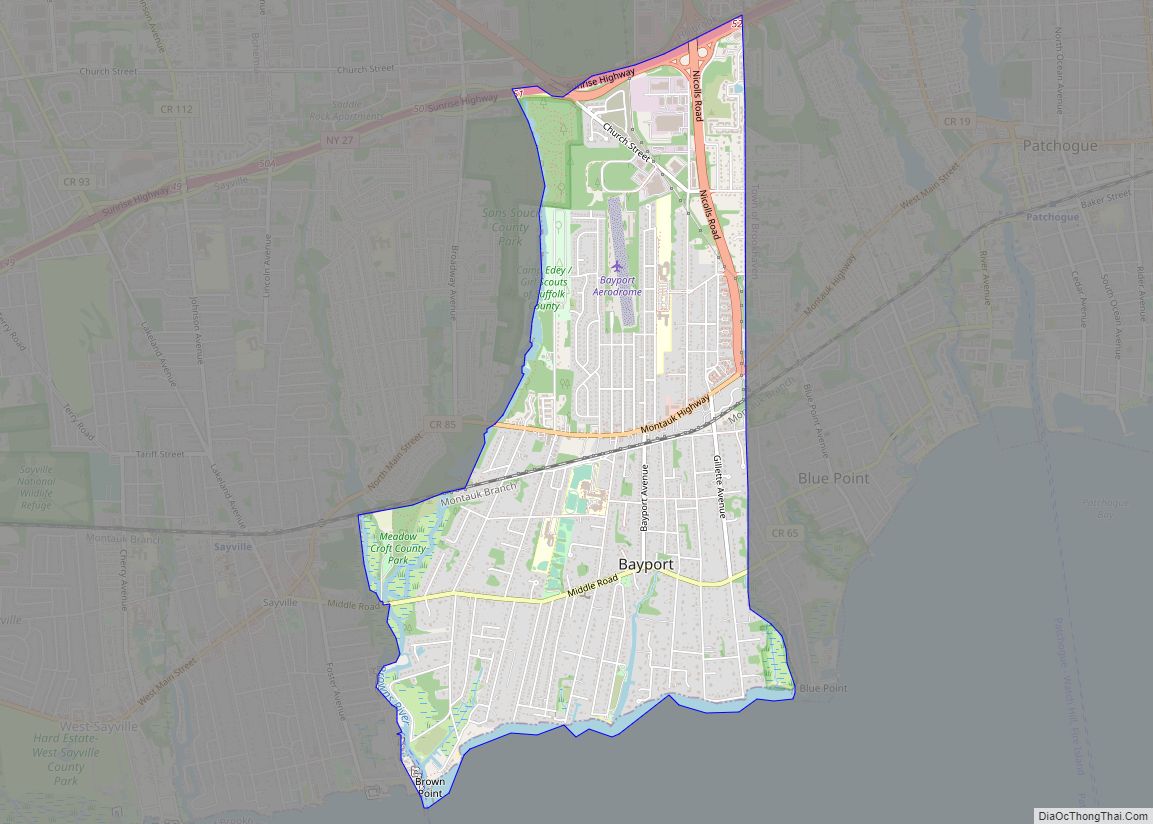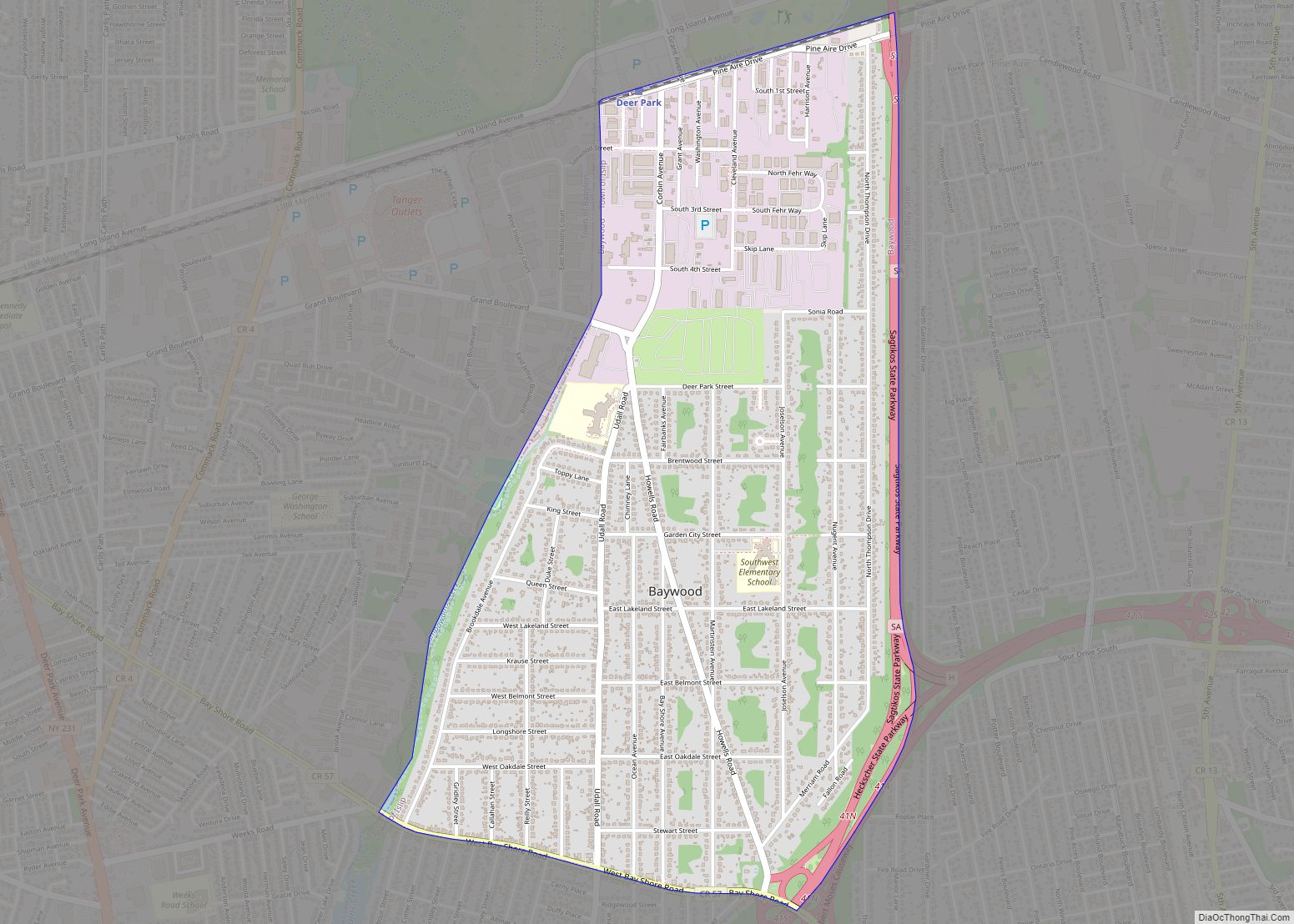Wyandanch (/ˈwaɪənˌdæntʃ/, WY-ən-danch) is a hamlet and census-designated place (CDP) in the Town of Babylon in Suffolk County, New York. The population was 12,990 at the 2020 census.
In the past, some or all of Wyandanch was proposed to become part of the never-realized Incorporated Village of Half Hollow Hills and later on proposed incorporating itself as the Incorporated Village of Wyandanch. However, those plans failed and Wyandanch has never been incorporated.
| Name: | Wyandanch CDP |
|---|---|
| LSAD Code: | 57 |
| LSAD Description: | CDP (suffix) |
| State: | New York |
| County: | Suffolk County |
| Elevation: | 56 ft (17 m) |
| Total Area: | 2.17 sq mi (5.63 km²) |
| Land Area: | 2.17 sq mi (5.62 km²) |
| Water Area: | 0.00 sq mi (0.01 km²) |
| Total Population: | 12,990 |
| Population Density: | 5,986.18/sq mi (2,311.16/km²) |
| ZIP code: | 11798 |
| Area code: | 631 |
| FIPS code: | 3683294 |
| GNISfeature ID: | 0971769 |
Online Interactive Map
Click on ![]() to view map in "full screen" mode.
to view map in "full screen" mode.
Wyandanch location map. Where is Wyandanch CDP?
History
Native settlement
This hamlet is named after Chief Wyandanch, a leader of the Montaukett Native American tribe during the 17th century. Formerly known as Half Way Hollow Hills, West Deer Park (1875), and Wyandance (1893), the area of scrub oak and pine barrens south of the southern slope of Half Hollow terminal moraine was named Wyandanch in 1903 by the Long Island Rail Road (LIRR) to honor Chief Wyandanch and end confusion between travelers getting off at the West Deer Park and Deer Park railroad stations. The history of the hamlet has been shaped by waves of immigrants.
No archaeological evidence of permanent Native American settlements in Wyandanch has been discovered. Native Americans hunted and gathered fruits and berries in what is now Wyandanch/Wheatley Heights.
The Massapequa Indians deeded the northwest section of what now is the town of Babylon to Huntington in the Baiting Place Purchase of 1698. The northeast section of the town of Babylon “pine brush and plain” was deeded to Huntington by the Secatogue Indians in the Squaw Pit Purchase of 1699. What is now Wyandanch is located in the Squaw Pit Purchase area. Lorena Frevert reported in 1949 that in the Baiting Place Purchase the Massapequa Indians “reserved the right of fishing and ‘gathering plume and hucel bearyes’.”
Colonial settlement and after
Wyandanch (West Deer Park before 1903) evolved out of what was originally known as the Lower Half Way Hollow Hills. The area was first settled by Captain Jacob Conklin after he was given a tract of land in what is now Wheatley Heights by his father, Timothy Conklin, about 1706. Gradually, pioneers from Huntington began settling along the southern slope of the Half Way Hollow Hills as they purchased farm and forestlands from the Conklins. What is known today as Wyandanch originated with the establishment of the West Deer Park LIRR station in 1875. The present-day Wyandanch railroad station sits on the site of the 1875 station on the Long Island Rail Road. Jacob Conklin’s 1710 “Pirate House” was the first house built in what became the town of Babylon.
The LIRR built the original West Deer Park railroad station, which incorporated a post office, in May 1875 at the request of General James J. Casey, a brother-in-law of President Ulysses S. Grant. Casey had purchased the 1,000-acre (400 ha) Nathanial Conklin estate in 1874, and he wanted a rail depot and post office located closer than the LIRR Deer Park depot that had opened in 1853. The 1875 West Deer Park/Wyandanch railroad station was demolished in 1958.
The first lots were sold near the station, around the time of a Long Island land boom in 1872. The efforts of a local realtor successfully targeted Germans and German-Americans.
In April 1903, the 1,343-acre (543 ha) ex-Conklin estate and historic Conklin family cemetery was sold to Bishop Charles Edward McDonnell of the Roman Catholic Diocese of Brooklyn, who resumed the bottling of spring water from the Colonial Spring. Eventually the McDonnell property became the Catholic Youth Organization’s (CYO) summer camp in Wyandanch. In 2011, 14-year-old Michael Berdon, a descendant of Jacob Conklin, restored the 257-year-old cemetery and laid a brick path approach to the gravesite with the assistance of several local businesses.
On March 8, 1907, the Wyandanch post office was moved from the LIRR depot to Anthony Kirchner’s General Store and Hotel on Merritt Avenue diagonally across from the railroad station.
Ethnic developments
Between 1880 and 1955, the dominant ethnic groups in Wyandanch were the German-Americans and Austrian-Americans. The earliest homes built in Wyandanch south of the LIRR were built by German and Austrian-American families. About a hundred “honest and frugal” German and Austrian-American families lived in Sheet Nine of the “City of Breslau” neighborhood as early as the 1880s. Germans and Austrians also worked in the Wyandance Brick and Terra Cotta works; prosperous German- and Austrian-Americans also lived in the hilly, secluded and sylvan Carintha Heights section, west of Conklin Street, which was developed by Brosl Hasslacher after the construction of the Long Island Motor Parkway.
Beginning in the 1920s and extending into the 1930s, working-class settlers (recently arrived from County Donegal in Ireland) began building small wood-frame bungalow-type homes in the fire-prone pine barrens in Wyandance Springs Park-there were no springs, no park and no roads-and in Home Acres. Irish and Irish-American families built homes on land they had purchased in the 1920s land bubble in Wyandance Spring Park or Home Acres. The newcomers wanted to escape from the crowded and economically depressed conditions in Manhattan and The Bronx, and yet be within an hour’s ride of the “City” on the LIRR. More affluent and prominent Irish-American families in Wyandanch lived nearer the “village” in more prosperous homes with larger plots of land.
African-Americans have lived in Wyandanch since the 1920s, when African-American families bought plots of land and built their own homes in the “Little Farms” section of the West Babylon school district between Straight Path, Little East Neck Road and Gordon Avenue. In the Upper Little Farms section bounded by Straight Path, Little East Neck Road and Grunwedel Avenue (now Patton Avenue) in the Wyandanch School District pioneering upwardly mobile African-American families also began building their own homes. Mortimer Cumberbach and Ignatius Davidson opened their C and D Cement Block Corp. on Booker Avenue at Straight Path on December 6, 1928; as late as the mid-1950s, C & D Cement Block was the only large business owned and operated by African-Americans in Suffolk County.
In the 1950s and 1960s, African-American families established homes south of the LIRR in the 1950s and 1960s. Many of these families—both middle class and working class—purchased homes in Wyandanch because they were denied opportunities to move into other fast-developing white housing tracts on Long Island (such as Levittown) due to exclusionist real estate practices: steering, restrictive covenants, red-lining or price points. The rapid development of Wyandanch in the 1950s as one of the largest African-American communities in Suffolk County transformed Wyandanch politically into a hamlet which by 1960 voted overwhelmingly Democratic. In the 1950s and 1960s, the political interest of African-Americans in Wyandanch was mainly focused on winning seats on the Wyandanch Board of Education.
In March 1951, Taca Homes, Inc. offered expandable four-room Cape Cod style homes for sale in Wyandanch on a “non-racial” basis at the Carver Park development at Straight Path and Booker Avenue. The 59 first stage homes with basement, hot-water heat and tile baths sold for $7,200 and were eligible for Federal Housing Administration loan insurance. Veterans were told that they only need put $365 down and could have a 30-year 4% mortgage. (See Brooklyn Daily Eagle, April 8, 1951) Carver Park was advertised as “interracial housing”. (Brooklyn Daily Eagle, April 8, 1951) Homes in the first and second sections of Carver Park were purchased almost exclusively by African-Americans. These homes required $600 down and veterans only had to pay $58.50 per month. The building of Carver Park and then the construction of Lincoln Park in 1956, with over 400 homes combined, triggered the transformation of Wyandanch from a mostly working class white community in 1950 to a majority working class African-American community in 1960, and in turn this caused white flight: many of the whites who lived south of the LIRR moved and lower middle class African-Americans bought or built modest, individual homes in Wyandanch Springs Park and in the “Tree streets” area east of Straight Path. In the 1960s many whites living in the Wyandanch school district #9 north of the Long Island Railroad in the Wyandanch School District also relocated.
Hispanic-American families began to settle in Wyandanch in the late 1940s since the community offered affordable housing and land, within easy commuting distance of nearby defense plants and Pilgrim, Edgewood, Central Islip, and Kings Park State Psychiatric Centers – where jobs were plentiful.
1967 racial disturbances
The “Long, hot summer of 1967” included a reaction to racial tensions in Wyandanch. Over the first three nights of August 1967, racial disturbances broke out in Wyandanch as small groups of young African-American adults reportedly smashed windows in three stores, overturned two cars, set fire to the auditorium of the (now named) Martin Luther King, Jr. Elementary School on Mount Avenue, set fires at the Wyandanch VFW Hall and ambulance garage at South 20th Street and Straight Path, threw stones at the Wyandanch Fire House and pelted police officers with rocks and bottles.
Suffolk County officials intervened quickly and inventoried problems included joblessness, lack of bus access to area businesses and factories, a lack of recreational facilities for youth, and a lack of African-American representation in the police force.
As a result of the August 1967 disturbances in Wyandanch, governments, private businesses, the Wyandanch School District, community church groups and individuals, residents and non-residents acted to address the numerous problems facing the community. The U.S. Office of Economic Opportunity and its Wyandanch Community Action Center worked to improve bus routes, develop job training programs and assist the indigent with accessing government services. The Great Atlantic & Pacific Tea Company (A&P) built a modern supermarket in downtown Wyandanch at the corner of Straight Path and Long Island Avenue. Today, this building houses Suffolk County’s Martin Luther King, Jr Community Health Center. Genovese Drugs opened a modern new store on the east side of Straight Path north of the Blue Jay shopping center.
Failed incorporation attempts
In the 1950s, some or all of Wyandanch and its neighbors Dix Hills and Melville, along with the area known as Sweet Hollow, proposed to incorporate as a single village. This village would have been known as the Incorporated Village of Half Hollow Hills, would have had an area of roughly 50 square miles (130 km), and would have embraced the Half Hollow Hills Central School District (CSD 5). The plans were unsuccessful, and each would remain unincorporated hamlets.
Wyandanch also tried incorporating as its own village in the 1980s, citing issues regarding race and neglect from the Town of Babylon. This village would have been known as the Incorporated Village of Wyandanch. However, these plans also failed, and Wyandanch remains an unincorporated hamlet governed by the Town of Babylon.
Wyandanch Road Map
Wyandanch city Satellite Map
Geography
According to the United States Census Bureau, the CDP has a total area of 4.5 square miles (11.6 km), all land. Wyandanch is a suburb of New York City. It is served by Exit 36 on the Southern State Parkway and Exit 50 on the Long Island Expressway.
The community was formerly known as Half Way Hollow Hills, West Deer Park (beginning in 1875), and Wyandance (in 1888). Topographically, Wyandanch’s nutrient-poor loam and sandy soils are part of the outwash plain which was formed as the last glacier melted about 10,000 BCE. The outwash plain slopes gently towards Belmont Lake State Park from the Half Way Hollow Hills terminal moraine and from Little East Neck Road.
In the mid and late 20th century, the Wheatley Heights area (Half Hollow Hills School District) developed as a separate community (due to class and racial dynamics) but is still served by the Wyandanch Fire Department and the US Postal Service.
See also
Map of New York State and its subdivision:- Albany
- Allegany
- Bronx
- Broome
- Cattaraugus
- Cayuga
- Chautauqua
- Chemung
- Chenango
- Clinton
- Columbia
- Cortland
- Delaware
- Dutchess
- Erie
- Essex
- Franklin
- Fulton
- Genesee
- Greene
- Hamilton
- Herkimer
- Jefferson
- Kings
- Lake Ontario
- Lewis
- Livingston
- Madison
- Monroe
- Montgomery
- Nassau
- New York
- Niagara
- Oneida
- Onondaga
- Ontario
- Orange
- Orleans
- Oswego
- Otsego
- Putnam
- Queens
- Rensselaer
- Richmond
- Rockland
- Saint Lawrence
- Saratoga
- Schenectady
- Schoharie
- Schuyler
- Seneca
- Steuben
- Suffolk
- Sullivan
- Tioga
- Tompkins
- Ulster
- Warren
- Washington
- Wayne
- Westchester
- Wyoming
- Yates
- Alabama
- Alaska
- Arizona
- Arkansas
- California
- Colorado
- Connecticut
- Delaware
- District of Columbia
- Florida
- Georgia
- Hawaii
- Idaho
- Illinois
- Indiana
- Iowa
- Kansas
- Kentucky
- Louisiana
- Maine
- Maryland
- Massachusetts
- Michigan
- Minnesota
- Mississippi
- Missouri
- Montana
- Nebraska
- Nevada
- New Hampshire
- New Jersey
- New Mexico
- New York
- North Carolina
- North Dakota
- Ohio
- Oklahoma
- Oregon
- Pennsylvania
- Rhode Island
- South Carolina
- South Dakota
- Tennessee
- Texas
- Utah
- Vermont
- Virginia
- Washington
- West Virginia
- Wisconsin
- Wyoming
